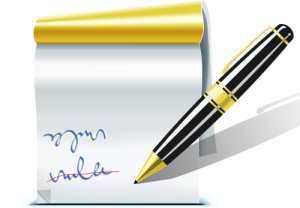Are you worried what an ICE audit might find in your I-9 records? You’re not alone. Many HR execs worry what an investigation by U.S. Immigration and Customs Enforcement (ICE) might uncover. 76 out of 100 paper I-9s have errors, and those errors come with expensive fines, so there is good reason to fear what might be lurking in your I-9s.
So what can you do to mitigate this risk? There are three approaches to scrubbing and cleansing your existing I-9s.
Approach 1: Manually detect and correct errors
 Until a few years ago, this was the only option available to employers. With this approach you deploy subject matter experts to review the I-9s for errors and to manually fix the errors they find. You can use internal experts, such as I-9 specialists in HR, or external I-9 experts such as attorneys or firms that specialize in auditing and correcting I-9s. Either way, auditing and correcting I-9s by hand on a large scale is extremely expensive as the labor cost adds up very quickly. For this reason not many large employers have done it.
Until a few years ago, this was the only option available to employers. With this approach you deploy subject matter experts to review the I-9s for errors and to manually fix the errors they find. You can use internal experts, such as I-9 specialists in HR, or external I-9 experts such as attorneys or firms that specialize in auditing and correcting I-9s. Either way, auditing and correcting I-9s by hand on a large scale is extremely expensive as the labor cost adds up very quickly. For this reason not many large employers have done it.
In addition to the cost, if your organization has multiple work locations where your I-9s are stored, you have to decide whether to get the files to the experts (pack and ship your I-9s to a central location) or get the experts to the files. Neither choice is perfect. One complication, for example, is that some errors can only be corrected in person with the employee.
Approach 2: Electronically detect errors, manually correct them
 A few years ago, a set of systems and services emerged that partially automate I-9 remediation. These solutions scan your paper I-9s to convert them into a digital format, then they electronically analyze the I-9s for errors. You get a report that highlights each error. The error report can be delivered in a spreadsheet, or in a system-based format that lets you click through to the records in error, as they are now in electronic format.
A few years ago, a set of systems and services emerged that partially automate I-9 remediation. These solutions scan your paper I-9s to convert them into a digital format, then they electronically analyze the I-9s for errors. You get a report that highlights each error. The error report can be delivered in a spreadsheet, or in a system-based format that lets you click through to the records in error, as they are now in electronic format.
In addition to analyzing the paper records you’ve scanned into the system, these I-9 solutions will also import and audit records created in another electronic system.
Newer versions of these systems specify what needs to be done to correct each error, which is significant as it means you can now use non-specialists to make the changes needed to bring your I-9s into compliance.
This partially-automated approach saves you the time of analyzing each record for errors. So instead of having to touch every record, you only need to touch the records in error. On average 24% of paper I-9s are error-free, so there are 24% fewer records you’ll have to touch. And, for the 76% of records you still have to touch, you’ll spend much less time on each record as you no longer need to find the errors. The task is simply to fix the errors that the system has already found for you.
By automating some of the critical elements of I-9 remediation, these systems provide value. However, even with some entire chunks of the manual labor eliminated, most employers still find it cost-prohibitive to remediate a large number of I-9s when each record in error has to be manually touched.
Approach 3: Auto-cleanse your I-9s
 A new class of electronic I-9 systems has just recently come on the market. These systems automate both the error analysis and correction. Like the systems in Approach 2, they analyze I-9 records that are scanned in from paper or imported from another electronic system. The difference is these advanced systems automatically correct a majority of the errors for you. With over half of the errors now being resolved without manual intervention, your workload is cut in half or more vs. your effort with Approach 2 described above. For the subset of records you have to touch, the time needed to fix the errors is compressed since the system spells out how to correct each error.
A new class of electronic I-9 systems has just recently come on the market. These systems automate both the error analysis and correction. Like the systems in Approach 2, they analyze I-9 records that are scanned in from paper or imported from another electronic system. The difference is these advanced systems automatically correct a majority of the errors for you. With over half of the errors now being resolved without manual intervention, your workload is cut in half or more vs. your effort with Approach 2 described above. For the subset of records you have to touch, the time needed to fix the errors is compressed since the system spells out how to correct each error.
By eliminating the majority of the manual labor, these auto-cleansing systems have finally made it viable for employers to remediate I-9 records on a large scale. The number of employers opting to use these systems is evidence of this. In the first 10 months after it was released, Tracker Corp’s auto-cleansing I-9 remediation solution was used by employers to cleanse over a million legacy I-9 records. These employers collectively eliminated over $500 million dollars in potential liability in just 10 months. Tracker’s product auto-resolves up to 74% of I-9 errors, so employers can now bring their active I-9s into full compliance with a fraction of the effort, time and expense of other approaches.
This post is part of our ongoing series on ICE I-9 audits. Check back or sign up to be alerted as we cover other topics. Other posts in the series include:
- 5 steps to take Before ICE knocks
- The ICE I-9 Inspection Process
- You just got an ICE I-9 audit notice: NOW WHAT??
-
The I-9 Audit: Lessons Learned in today’s webinar with ICE
Discover how Tracker’s auto-cleansing I-9 remediation solution can automatically perfect up to 74% of your paper I-9 records while you sleep.
Disclaimer: The content of this post does not constitute direct legal advice and is designed for informational purposes only.